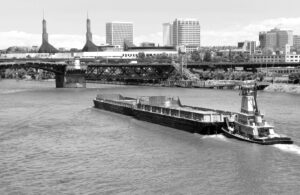Technology On The Waterways:
Better Use Of Data Translates To Better Bottom Line
By Mark Peterman
President, Cornerstone Solutions Group
When BargeOps develops solutions for our customers along the waterways, we’re seeing an across the board shift toward data-driven decision making. Companies both small and large increasingly make decisions based on analysis of their business using data, not just experience. The trick has been getting the right data into the right hands to analyze the operation.
The big challenge for large companies operating on our inland waterways is that they’ve got data in multiple systems that need to come together for meaningful analysis. The big challenge for small companies is justifying the investment with a smaller subset of data. In both cases, the technology to make this happen is getting easier to use and less costly to implement.
The term “big data” is all over the news the last few years. Of course it means a collection of data so large or complex that it becomes difficult to analyze using traditional applications. What’s important about data is not that it’s “big,” but that it’s meaningful, relevant, and timely. Having easy access to data across all parts of your business can have a profound effect on your decision-making and profitability.
No matter what your business is within the inland marine industry, it’s likely that you’re running an operational system like BargeOps to manage daily activities. This is typically separate from the financial system. Whether your financials reside in an enterprise class solution or in a QuickBooks environment, you’ll want to match up financial and operational data to get a complete picture of your operation. Today, that’s a pretty major spreadsheet exercise. But there’s a better way.
Let’s use the towing business as an example. Boats are valuable assets. Clearly, you don’t want them sitting around. You want them engaged in activities that drive revenue. An operational system keeps track of all planning, order-tracking and fulfillment, boat positions, and additional data about the operations of the business. It really isn’t built to help analyze data beyond operational reports.
A baseline analysis would start by examining the utilization of those assets. As long as you can access the data, it’s easy to review overall utilization or billable time by month and then drill down into detailed billable time by boat. As you dig deeper, you can look at the breakdown of activities to understand how much time is spent in transit, delays, and pick-up or drop-off activities as a few examples. You can also analyze the details of barge trips between various origin-destination pairs in order to better understand trends that can impact costs and profitability.
To really understand what’s driving your financial performance, you add pricing information, revenue data, and expense data so you can really get a deep understanding of the profitability of customers and even specific contracts. With this information, you can negotiate contract renewals with the knowledge necessary to propose terms that will have a direct positive impact on your profit.
Of course, what really makes things work is profitability. Do you know who your most profitable customers are? Do you know what contracts are most profitable or least profitable? Do you know why? Companies are gaining a deeper understanding of the profitability of their customers and contracts by bringing together the detailed operational data (activities) with pricing, revenue, and expense data.
As an example of looking at expense data, several of the smartest towing operations are gaining insights on third-party expenses associated with delivering on contracts. For example, as a towing company you might find that you have more (or less) fleeting expense associated with a particular customer contract than expected. You might also find opportunities to change demurrage terms after analyzing historical demurrage data in more detail.
How do you get the data into a form that’s reliable and easy to analyze? BargeOps sees more and more companies employing technologies like a data warehouse that centralizes the data from the various systems that run the company and makes it easy to access and analyze. Along with the data warehouse, the tools to quickly drill into the data continue to improve. Software solutions like Tableau make it easy to find answers to your questions in your data. It’s fast, easy to use, and low-cost.
This type of a solution provides accurate and timely information and often a few surprises versus your current view.
Mark Peterman became president and chief executive officer of Cornerstone Solutions Group in 2013, after a 25-year career in process engineering, technical management, marketing and general management. CSG is the developer of BargeOps software, which is a full-featured towing, fleet, and terminal management solution created for the inland marine industry.


